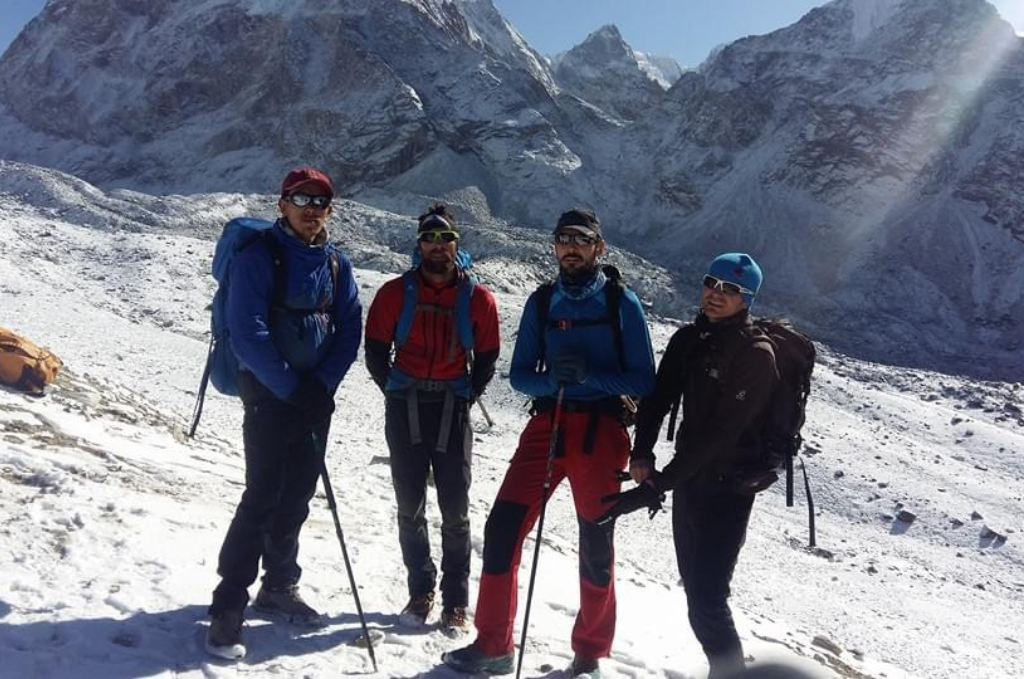 " alt="Island Peak
" alt="Island Peak
Island Peak
Island Peak, also known as Imja Tse, is a prominent trekking peak located in the Everest region of Nepal. Rising to an altitude of 6,189 meters (20,305 feet), it offers adventurers a challenging yet achievable climbing experience. The ascent typically involves a mix of trekking through the scenic Khumbu Valley and technical glacier climbing. From the summit, climbers are rewarded with breathtaking panoramic views of some of the world’s highest peaks, including Everest, Lhotse, and Nuptse.
FAQ
How difficult is it to climb Island Peak?
Climbing Island Peak requires a good level of physical fitness and some prior mountaineering experience. While it’s considered one of the more achievable trekking peaks in Nepal, climbers should be prepared for technical glacier climbing and high altitude conditions.
What equipment do I need to climb Island Peak?
Climbers typically need technical climbing gear, including harnesses, crampons, ice axes, helmets, and ropes. It’s also essential to have proper clothing for cold and high-altitude conditions and personal gear such as a sleeping bag, backpack, and trekking poles.
Is altitude sickness a concern when climbing Island Peak?
Yes, altitude sickness is a significant concern when climbing Island Peak, as the summit sits at an elevation of 6,189 meters (20,305 feet). Proper acclimatization and a gradual ascent are essential to minimize the risk of altitude-related illnesses
Do I need a climbing guide to climb Island Peak?
While it’s possible to climb Island Peak without a guide, hiring an experienced climbing guide is highly recommended or joining a guided expedition. Guides can provide valuable assistance with route finding, safety, and technical skills, increasing your chances of a successful and safe climb.
What is the best time of year to climb Island Peak?
The best time to climb Island Peak is during the spring (March to May) and autumn (September to November) seasons. During these months, the weather is generally more stable, with clear skies and mild temperatures, making for safer and more enjoyable climbing conditions.
How long does it take to climb Island Peak?
The duration of the climb depends on various factors, including your level of fitness, acclimatization schedule, and weather conditions. Typically, the climb takes around 14 to 16 days, including trekking to and from the mountain, acclimatization days, and the summit attempt.
What is the success rate for climbing Island Peak?
The success rate for climbing IslandPeak varies depending on individual climbers’ experience, preparation, and weather conditions. With proper training, acclimatization, and guidance from experienced climbers and guides, the success rate can be relatively high, but it’s essential to be prepared for challenges.
Itinerary
Day 1 : Arrival in Kathmandu
Arrival at Tribhuwan International Airport (TIA), Kathmandu.
Transfer to Yatri Suites and Spa Hotel.
Visit Himalayan Glacier’s office for trip briefing.
Welcome dinner with Nepali cuisine.
Overnight in Kathmandu.
Day 2 : Fly to Lukla, Trek to Phakding
Early flight to Lukla, scenic mountain views.
Trek to Phakding, short hike for acclimatization.
Optional visit to a nearby monastery.
Overnight in Phakding.
Day 3 : Phakding to Namche Bazaar
Trek through pine forests along Dudh Koshi River.
Views of Mt. Thamserku and possibly Mt. Everest.
Entrance to Sagarmatha National Park.
Cross several suspension bridges.
Overnight in Namche Bazaar.
Day 4 : Namche Bazaar: Acclimatization Day
Acclimatization day in Namche Bazaar.
Explore village or hike to Everest View Hotel.
Visit local museum or Khumjung village.
Overnight in Namche Bazaar.
Day 5 : Namche Bazaar to Tengboche
Trek to Tengboche with views of Everest, Nuptse, Lhotse, Ama Dablam, and Thamserku.
Visit Tengboche Monastery.
Overnight in Tengboche.
Day 6 : Tengboche to Dingboche
Trek through forests of birch, conifers, and rhododendrons.
Visit Pangboche Monastery.
Overnight in Dingboche.
Day 7 : Dingboche to Chhukung
Trek to Chhukung with views of Ama Dablam and Lhotse-Nuptse ridge.
Overnight in Chhukung.
Day 8 : Acclimatization: Climb Chhukung Ri
Hike up Chhukung Ri for acclimatization.
Views of Ama Dablam and Amphu Labsa peaks.
Overnight in Chhukung.
Day 9 : Chhukung to Island Peak Base Camp
Trek to Island Peak Base Camp.
Overnight at Base Camp.
Day 10 : Pre-Climb Training on Island Peak Base Camp
Peak climbing techniques and equipment training.
Optional hike to high camp for acclimatization.
Overnight at Base Camp.
Day 11 : Island Peak Base Camp to Summit, back to Base Camp
Early morning start for summit.
Use of fixed ropes on steep slopes.
Summit views, descend to Base Camp.
Overnight at Base Camp.
Day 12 : Island Peak Base Camp to Pangboche
Descend to Pangboche.
Visit Upper Pangboche Gompa.
Overnight in Pangboche.
Day 13 : Pangboche to Namche Bazaar
Retrace steps back to Namche Bazaar.
Overnight in Namche Bazaar.
Day 14 : Namche Bazaar to Lukla
Descend to Lukla via suspension bridges.
Overnight in Lukla.
Day 15 : Fly to Kathmandu
Early flight to Kathmandu.
Free day for relaxation or exploration.
Farewell dinner in the evening.
Overnight in Kathmandu.
Day 16 : Final Departure
Transfer to Tribhuwan International Airport for departure.
Join us at Himalayan Sherpani Adventure and discover the true spirit of the Himalayas.